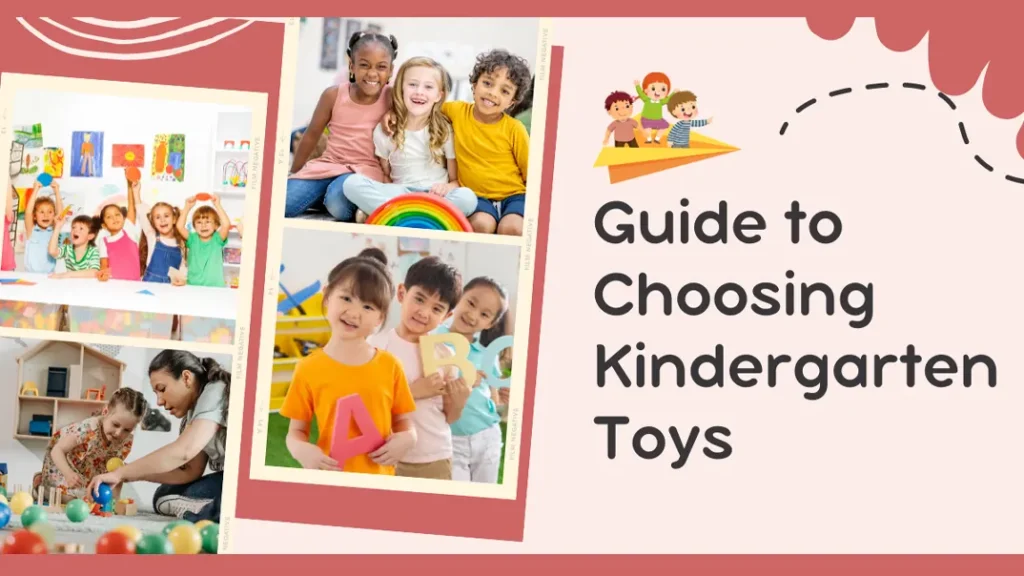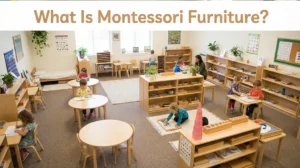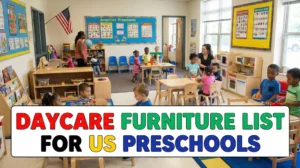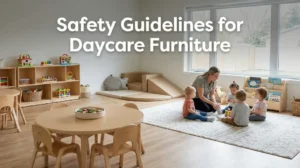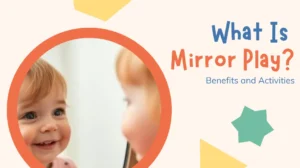When it comes to kindergarten, choosing age-appropriate kindergarten toys isn’t just about fun. The right choices can significantly impact your child’s cognitive, social, and emotional development. And the wrong decisions can hinder it. But with so many options, how do you ensure you choose the best?
Choosing age-appropriate toys involves understanding child development stages, recognizing safety standards, and considering educational value. A well-chosen toy entertains and stimulates growth, creativity, and learning.
Whether you’re looking for toys that stimulate the imagination or promote fine motor skills, our guide has you covered. It’s time for your child to enjoy fun, educational, and engaging playtime.
Understanding the Impact of Toys on Child Development
Understanding how children develop is crucial when selecting Age-Appropriate Kindergarten Toys. Each stage of development requires different types of toys to support growth in various areas.
Cognitive Development
Cognitive development in young children involves learning to think, explore, and figure things out. Problem-solving toys play a significant role in this process. These toys encourage kids to use their brains to solve puzzles or challenges. For instance, building blocks, shape sorters, and simple puzzles can help children develop logic and problem-solving skills. A study titled ‘The Puzzle of Playtime: Which Toys Can Support a Child’s Logic and Problem-Solving Skills?’ highlights that fewer toys can enhance cognitive development by reducing distractions.
Physical Development
Physical development focuses on improving motor skills and overall body coordination. Toys that promote motor skills are essential for this stage. Tricycles, jump ropes, and lightweight balls encourage physical activity and coordination. These toys help children develop strength, balance, and agility. Active toys also provide a fun way for kids to burn off energy while developing important physical skills.
Social and Emotional Development
Social and emotional development involves learning to interact with others and manage emotions. Toys play a vital role in social interaction. Toys that encourage sharing and cooperation help children learn to work together. Dolls, puppets, and playsets can foster social skills by encouraging role-playing and storytelling. These activities teach kids how to express themselves and understand others’ feelings. Such interactions are crucial for building empathy and communication skills.
Choosing the right age-appropriate kindergarten toys can significantly impact a child’s development. Parents can select toys that support cognitive, physical, and social-emotional growth by understanding these developmental stages

Kindergarten Toys by Age
Choosing age-appropriate kindergarten toys for different age groups promotes cognitive, social, and emotional development. The best toys not only entertain but also educate and promote skills that are critical at every stage of development. By understanding the appropriate toys for each age group, you can make informed decisions that support your child’s development.
1. Toys for 0 to 6 Months Old
At this tender age, infants are just beginning to explore their surroundings. Their senses rapidly develop, and toys that stimulate sight, sound, and touch are essential.
- Rattles and Soft Toys: These stimulate auditory and tactile senses. Rattles help babies learn cause and effect, while soft toys provide comfort and are safe for mouthing.
- High-Contrast Toys: Toys with bold patterns in black, white, and bright colors are excellent for visual stimulation. Babies are drawn to high contrast as their vision develops.
At this stage, safety is paramount. All toys should be soft, non-toxic, and large enough to avoid choking hazards.
2. Toys for 6 to 12-Month-Olds
As babies approach their first year, they become more active and curious. Toys that encourage movement, exploration, and problem-solving are ideal.
- Teething Toys: Babies at this age love to chew on things as they teethe. Look for BPA-free, easy-to-hold toys that soothe sore gums.
- Activity Centers: Multi-sensory activity centers with buttons, lights, and sounds can engage babies and help develop their fine motor skills.
- Stacking Rings: These introduce concepts of size and order and are great for hand-eye coordination.
Ensuring that toys are durable and easy to clean is crucial at this stage, as everything will end up in the baby’s mouth.
3. Toys for 1 to 2-Year-Olds
This is a critical period for language development and physical coordination. Toddlers learnk, talk, and explore their environment more independently.
- Push and Pull Toys: These toys support balance and coordination as toddlers begin to walk. They encourage active play and physical development.
- Shape Sorters and Building Blocks: These toys promote problem-solving skills and fine motor development. They also introduce basic concepts of shapes and colors.
- Pretend Play Toys: Simple dolls, toy kitchens, and cars help children begin to engage in imaginative play, which is vital for social and cognitive development.
- Musical Instruments: Simple instruments like drums, maracas, and xylophones are excellent for sensory development and can introduce rhythm and sound exploration.
This is also the age when children start to show preferences for certain types of play, so offering a variety of toys can cater to different interests.
4. Toys for 3 to 6-Year-Olds (Preschoolers and Kindergartners)
As children enter preschool and kindergarten, their play becomes more imaginative and social. Toys that encourage creativity, cooperation, and problem-solving are key.
- Educational Toys: At this age, children are ready for toys that teach basic literacy and numeracy skills. Alphabet puzzles, counting games, and magnetic letters are great tools for introducing these concepts.
- Art and Craft Supplies: Creativity is a hallmark of this stage. Providing children with crayons, markers, paints, and playdough allows them to express themselves artistically. These activities enhance fine motor skills and foster a love for creative expression.
- Role-Playing Toys: Toys like dollhouses, play kitchens, and doctor kits encourage imaginative play. Through role-playing, children develop social skills, understand different perspectives and practice real-world scenarios.
- Outdoor Play Equipment: Simple outdoor equipment like tricycles, balls, and slides help develop gross motor skills.
- Building Blocks and Construction Sets: Promote creativity, spatial awareness, and fine motor skills. LEGO sets, wooden blocks, and magnetic tiles are popular choices.
At this stage, toys should challenge children without causing frustration, promoting confidence as they master new skills.
5. Toys for School-Age Children (6-12 Years Old)
As children grow older, their play becomes more sophisticated, and their interests expand. Toys for school-age children should challenge their minds, support their hobbies, and encourage social interaction.
- STEM Toys: Science, Technology, Engineering, and Mathematics (STEM) toys are excellent for this age group. Building sets like LEGO, robotic kits, and science experiment kits stimulate logical thinking, problem-solving skills, and curiosity about how things work.
- Board Games and Puzzles: Toys such as chess, checkers and complex puzzles promote strategic thinking, patience and teamwork, enhancing cognitive and social skills.
- Sports Equipment: Encouraging physical activity is still important at this age. Sports equipment such as soccer balls, basketballs, and bicycles help children develop coordination, strength, and a sense of teamwork.
- Creative Toys: Musical instruments, advanced art supplies, and crafting kits allow older children to explore their talents and hobbies.
These toys should be age-appropriate in complexity, ensuring they’re engaging without being too difficult.

Tips for Choosing Age-Appropriate Kindergarten Toys
1. Safety First
Safety is always a top priority when selecting toys for young children. Children are naturally curious at this age and often explore the world with their hands and mouths, so it’s vital to choose toys free of small parts, toxic materials and sharp edges. Always check that toys meet the necessary safety standards and certifications in your area.
2. Long-Lasting
Investing in high-quality, durable toys can save money in the long run and provide children with consistent, reliable playtime experiences. Long-lasting toys can withstand the wear and tear of daily play and grow with the child.
3. Easy to Use
Toys should be easy for children to use, allowing them to engage independently or with minimal adult assistance. This encourages autonomy and boosts their confidence as they interact with the toy.
4. Educational Value
The best kindergarten toys are those that combine fun with learning, helping children teach skills such as problem-solving, creativity, and critical thinking while they play.
5. Consider the Child’s Age and Developmental Stage
Choosing the right toy requires considering the child’s age and stage of development. Different ages have different developmental needs and toys should meet these needs to be effective. Pay attention to the recommended age range on the toy’s packaging, but also consider your child’s abilities and interests.
6. Consider the Child’s Interests
Every child has unique interests, and toys that cater to these can be particularly engaging. Understanding what a child enjoys can help you choose toys that will capture their attention and inspire them to learn more.
7. Choose Toys with Multiple Uses
Kindergarten toys that can be used in various ways provide additional value and opportunities for creative play. Children can use them in different settings or combine them with other toys to make them more versatile.
8. Toys that Encourage Exploration and Problem Solving
Children learn best when they are actively engaged in solving problems and exploring new ideas. Toys that promote these skills are invaluable for cognitive development and can help children build confidence as they learn.
Choosing age-appropriate kindergarten toys requires consideration of a range of factors. Following these tips, you can choose toys that entertain and support your child’s development across multiple domains.
Things to Avoid When Buying Kindergarten Toys
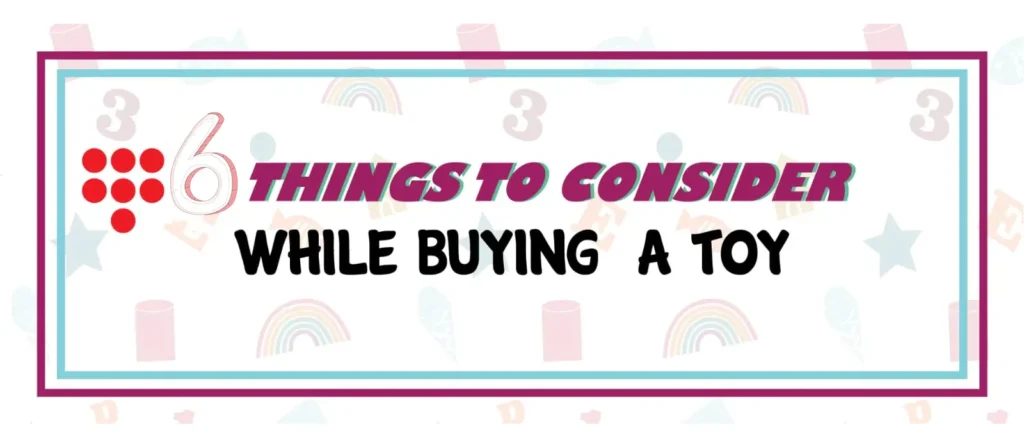
- Overstimulation: Overly stimulating Toys can overwhelm young children, leading to anxiety and distraction rather than engagement and learning. These toys often feature bright lights, loud noises, and rapid movements.
- Unchallenging: Toys that are too simple or unchallenging fail to stimulate a child’s cognitive and physical development. When toys don’t provide an adequate challenge, children can quickly lose interest, missing out on opportunities to learn and grow.
- Limited Applicability: Toys with limited applicability or those that can only be used in one specific way often fail to hold a child’s interest for long. They offer little opportunity for creativity or exploration.
- Avoid Electronic Toys: Electronic toys are often marketed as educational, but they can sometimes do more harm than good. These toys can limit a child’s creativity, encourage passive interaction, and lead to dependency on screens or electronic devices.
- Buying Toys Based on Trends: Popular toys might capture children’s attention temporarily, but they might not offer much in terms of developmental value. Always prioritize long-term educational benefits over short-term entertainment.
- Overloading with Too Many Toys: Too many kindergarten toys can overwhelm children and reduce the effectiveness of playtime. It’s better to have fewer, high-quality toys that children can explore in depth.
Types of Toys That Promote Different Skills
Choosing the right toys can help your child learn, grow and have fun. Let’s take an in-depth look at the different types of toys that promote a variety of skills.
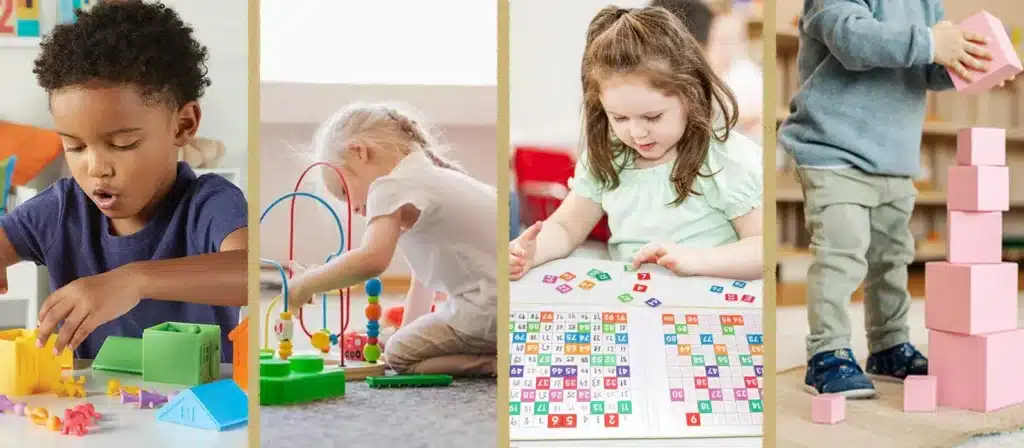
Educational Toys
Educational toys are fantastic for sparking curiosity and learning. These toys can teach kids about numbers, letters, and even science. STEM toys, like robots and coding kits, introduce children to technology and programming. These toys develop logical thinking and problem-solving skills. Kids get excited about science and engineering through play.
Benefits of Educational Toys
Educational toys offer many benefits. They encourage kids to explore new concepts and ideas. Children learn while having fun. These toys also help improve concentration and focus. Kids develop critical thinking skills as they solve puzzles or build structures.
Examples of Educational Toys
Some great examples of educational toys include:
- Building blocks: Help kids understand shapes and spatial relationships.
- Puzzle games: Enhance problem-solving skills and patience.
- Science kits: Encourage exploration and discovery.
Creative Toys
Creative toys inspire imagination and creativity. Kids express themselves and create their own stories. These toys allow children to explore their artistic side.
Encouraging Creativity and Imagination
Creative toys provide endless possibilities. Kids use their imagination to create new worlds. These toys help children think outside the box. Creativity boosts confidence and self-expression. Kids learn to appreciate beauty and art.
Examples of Creative Toys
Here are some popular creative toys:
- Art supplies: Paints, crayons, and markers for artistic expression.
- Dress-up clothes: Encourage role-playing and storytelling.
- Musical instruments: Introduce kids to music and rhythm.
Interactive Toys
Interactive toys engage kids in social play. These toys help children learn how to interact with others. Kids develop communication skills and teamwork.
Enhancing Social Skills Through Play
Interactive toys bring kids together. Children learn to share and take turns. These toys promote collaboration and friendship.
Examples of Interactive Toys
Consider these interactive toys for your child:
- Board games: Teach strategy and cooperation.
- Puppets: Encourage storytelling and role-playing.
- Playsets: Foster group play and imagination.
Montessori Toys(Montessori Materials)
Montessori toys, also known as Montessori Materials aids, are a special teaching resource to support and enable the Montessori educational method. Founded by Italian physician and educator Maria Montessori, this educational method is centered on promoting the child’s holistic growth through self-directed learning, self-directed activities, and practices geared to the child’s natural developmental stages.
Benefits of Montessori Toys
Montessori toys encourage self-directed learning and exploration through their unique design, promoting the development of independence and self-confidence. These toys often self-correct, allowing children to operate with minimal guidance and learn through trial and error. In addition, Montessori teaching aids help children develop fine motor skills and increase sensory sensitivity.
Examples of Montessori Toys
- Wooden Puzzles: Help children develop problem-solving skills and spatial awareness.
- Practical Life Toys: Learning how to care for themselves and their surroundings.
- Sensory Toys: Help children explore their senses and improve tactile discrimination.
- Math Beads and Counting Sets: Help children understand math concepts through hands-on manipulatives.
- Language Development Tools: Develop their reading and writing skills.
- Stacking and Sorting Toys: Promote logical thinking, pattern recognition and fine motor skills.
How to Balance Cost and Quality?
Should You Always Go for the Cheapest Option?
While budget constraints are a reality for many kindergartens, choosing the cheapest toys can be a false economy. Lower-quality toys often break easily and may not meet safety standards, leading to more frequent replacements and potential safety issues.
How Can You Get the Best Value for Money?
Look for kindergarten suppliers who offer bulk discounts or package deals, especially if you’re purchasing for a large kindergarten. Another option is to choose versatile toys that can be used in multiple ways, which provides more value for money.

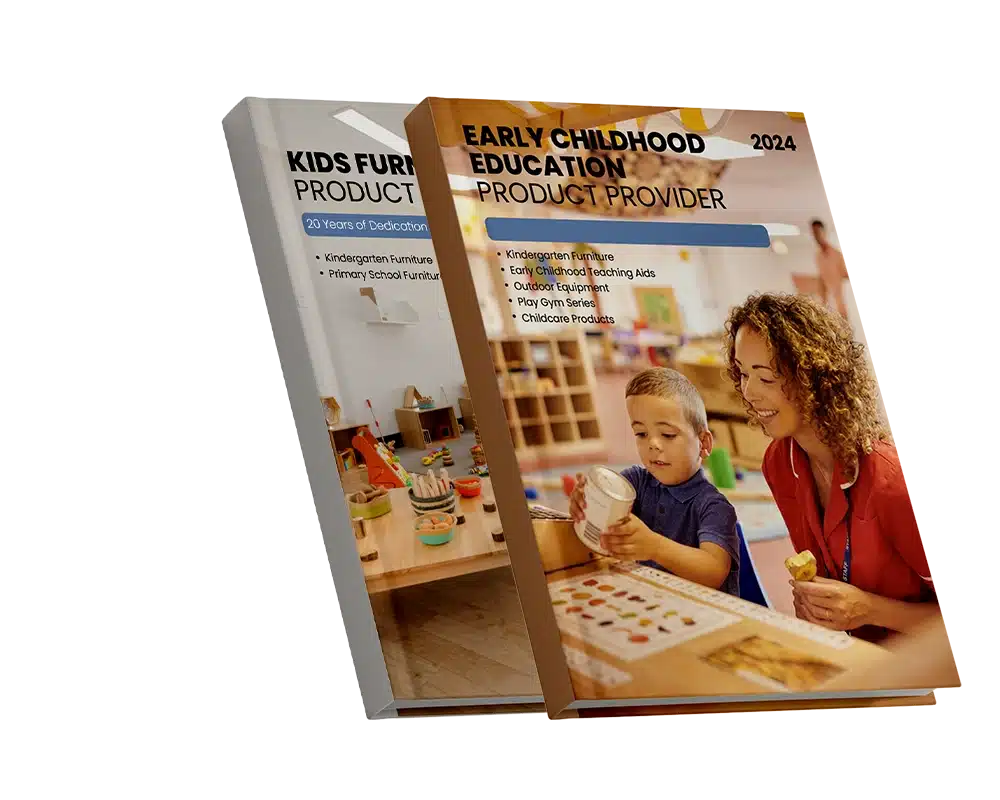
Questions Every Parent Should Ask
- Is this toy safe for my child?
- Does this toy offer educational value?
- Is this toy age-appropriate?
- Does this toy encourage creativity?
- Will this toy engage my child?
- Is this toy versatile?
- Is the Toy Durable?
- Is the Toy Open-Ended?
- Does the Toy Encourage Physical Activity?
- How do I ensure a toy will engage my child over time?
Conclusion
Choosing age-appropriate kindergarten toys is an important aspect of kindergarten education. You can create a nurturing and stimulating environment that supports their growth by considering developmental needs, cognitive, social, and emotional development, safety, and educational values. Remember, the right toys can have a huge impact on a child’s early development.

